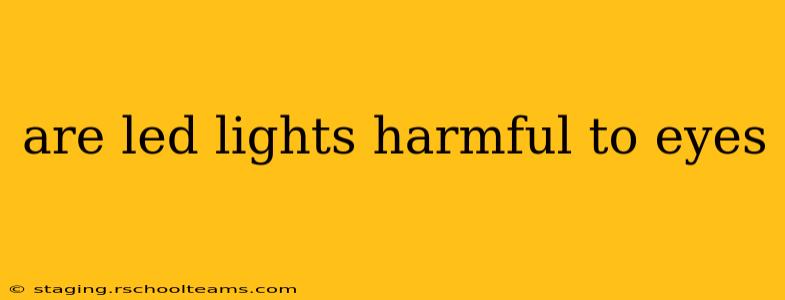The question of whether LED lights are harmful to eyes is a complex one, sparking considerable debate. While generally considered safe, certain aspects of LED lighting warrant careful consideration. This comprehensive guide delves into the potential risks and benefits, answering common concerns and providing practical advice to minimize any negative impacts.
What are the Potential Harmful Effects of LED Lights on Eyes?
The primary concern surrounding LED lights and eye health centers on blue light emission. LEDs, particularly those with higher color temperatures (appearing more "cool" or white), emit a significant amount of blue light. Exposure to excessive blue light can contribute to several issues:
- Eye Strain: Prolonged exposure to bright light, including blue light from LEDs, can lead to digital eye strain, characterized by symptoms like dry eyes, headaches, blurred vision, and eye fatigue. This is especially relevant for those who spend many hours in front of screens.
- Macular Degeneration: While research is ongoing, some studies suggest a potential link between long-term, high-intensity blue light exposure and an increased risk of age-related macular degeneration (AMD), a leading cause of vision loss in older adults. However, the relationship is not definitively established, and other factors play a more significant role in AMD development.
- Sleep Disturbances: Blue light suppresses melatonin production, a hormone crucial for regulating sleep-wake cycles. Exposure to blue light from LEDs close to bedtime can disrupt sleep patterns, leading to insomnia and fatigue.
Are LED Lights Always Harmful?
No, LED lights are not inherently harmful. The potential risks are largely associated with overexposure to bright light and high levels of blue light, particularly at night. Modern LEDs offer various color temperatures and dimming capabilities, allowing for customizable lighting solutions that minimize potential harm.
How Can I Minimize the Harmful Effects of LED Lights?
Several strategies can mitigate the potential risks associated with LED lighting:
- Choose lower color temperature LEDs: Opt for warmer-toned LEDs (2700K-3000K), which emit less blue light than cooler-toned LEDs (5000K and above). These warmer lights are generally more comfortable for the eyes.
- Use dimmers: Dimming your LED lights reduces the overall light intensity, thereby minimizing blue light exposure and eye strain.
- Take regular breaks: If you work or spend extended periods in front of LED-lit screens, take frequent breaks to rest your eyes and reduce eye strain. Follow the 20-20-20 rule: Every 20 minutes, look at something 20 feet away for 20 seconds.
- Use blue light filter glasses: These glasses can help block a portion of the blue light emitted from screens and LED lights. This is particularly beneficial for those who work at night or spend long hours on electronic devices.
- Maintain good lighting design: Ensure adequate ambient lighting to prevent excessive strain on your eyes. Avoid harsh, direct light sources.
What is the difference between LED and other lighting types?
Compared to incandescent and fluorescent lighting, LEDs offer several advantages, including energy efficiency and longer lifespan. However, the blue light emission is a key difference to consider. While incandescent bulbs emit very little blue light, fluorescent bulbs also produce some blue light. LED technology's versatility in color temperature allows for choices that minimize blue light exposure.
Do LED lights cause headaches?
Headaches can be a symptom of eye strain caused by prolonged exposure to bright LED lights, particularly those with high blue light content. However, headaches are not solely attributed to LEDs; other factors, such as poor posture and dehydration, also contribute. If you experience frequent headaches associated with LED lighting, consider adjusting lighting levels, taking breaks, and using blue light filter glasses.
Are there different types of LED lights?
Yes, LED lights vary significantly in terms of color temperature, brightness, and blue light emission. Understanding these variations is crucial for choosing LEDs that best suit your needs and minimize potential eye strain.
Can LED lights damage your eyes?
While extensive damage to the eyes from LEDs is rare, prolonged exposure to high intensity blue light can contribute to eye strain, potentially increasing the risk of long-term issues like AMD. The crucial factor is responsible use and minimizing prolonged exposure to bright LED light.
In conclusion, while LEDs can pose some risks to eye health, especially with prolonged exposure to intense blue light, these risks can be significantly mitigated through conscious choices in lighting selection and usage habits. By understanding these risks and implementing the preventative measures outlined above, you can enjoy the benefits of LED lighting while minimizing any potential negative impact on your vision.
